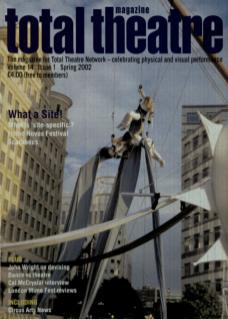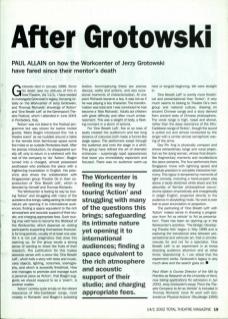Grotowski died in January 1999. Since his death (see my obituary of him in Total Theatre, Vol 11/1), I have started to investigate Grotowski's legacy, focusing initially on the Workcenter of Jerzy Grotowski, and Thomas Richards' showings of Action and One Breath Left at the Generazioni Theatre Festival, which I attended in June 2001 in Pontedera, Italy.
Action was not listed in the Festival programme but was shown for twelve invited guests. Mario Biagini introduced this 'not a theatre event' as we huddled around a table in the remote brick farmhouse space some five miles or so outside Pontedera itself. After his precise introduction, he disappeared quietly off, only to return in a whirlwind with the rest of the company to 'do' Action. Biagini turned into a charged, almost possessed soothsayer who prefaces the piece with a frightening incantation in English. His presence also drives the collaboration with Singaporean group Theatre Ox in their co-production of One Breath Left, which is directed by himself and Thomas Richards.
The Workcenter is feeling its way by touring Action and struggling with many of the questions this brings: safeguarding its intimate nature yet opening it to international audiences; finding a space equivalent to the rich atmosphere and acoustic support of their studio; and charging appropriate fees. Such touring may well have to become the lifeblood of the Workcenter, which depends on visiting participants supporting themselves financially for long periods, usually of at least one year. Yet it is not just pragmatics that drive this opening up, for the group exude a strong sense of wanting to share the fruits of their research. The justification for this makes absolute sense with a piece like One Breath Left, which tells a story with texts and music, uses objects, lighting, costumes, scenography, and which is avowedly theatrical. How one manages to promote and manage such a personal piece as Action, that Biagini suggests we should respond to as a 'poem', is another matter.
Action centres quite simply on the vibrant resonance of Afro-Caribbean songs, most notably in Richards' and Biagini's pulsating bodies. Accompanying these are precise dances, walks and actions, and very occasional moments of characterisation. At one point Richards became a boy. It was not as if he was playing a boy character. The transformation was total and I was convinced he had become ‘a little Richards'. Adults act children with great difficulty and often much embarrassment. This was a sleight of body, a fleeting moment in a storm of actions.
For One Breath Left, five or so rows of seats created the auditorium and two long streams of coloured cloth made a funnel-like stage space. The performers swept through the audience and onto the stage in a whirl. This group have refined the art of dramatic entrances – surprisingly rapid appearances that leave you immediately expectant and focused. There was no audience warm-up here or languid beginning. We were straight in.
One Breath Left is overtly more theatrical and presentational than Action. It very much seems to belong to Theatre Ox's own group and national culture, drawing on ancient Chinese songs and a story derived from ancient texts of Chinese philosophers. The vocal range is high, nasal and atonal, rather than the deep resonance of the Afro-Caribbean songs of Action, though the sound is pulled out and almost conducted by the singer with a similar almost semaphoric waving of the arms.
Gey Pin Ang is physically compact and shows extraordinary range and vocal projection as the dying woman, whose final dream-like fragmentary moments and recollections the piece presents. The four performers from Singapore move with lightning speed and absolute precision in complete interactive harmony. This rigour is tempered by moments of light comedy, including a hand-puppet play above a tautly stretched white sheet and the absurdity of familiar philosophical conundrums spoken emphatically and energetically in pidgin English, projected directly to the audience in storytelling mode. No word is ever lost to poor enunciation or projection.
The partnering of One Breath Left with Action makes sense in showing a progression from ‘Art as vehicle' to 'Art as presentation'. There has been an opening up in the Workcenter's activities. ‘The Bridge: Developing Theatre Arts' began in May 1999 and is exploring the transitional area between presentational and vehicular art, that is simultaneously for and not for a spectator. One Breath Left is an experiment in at times directing audience attention and at other times 'abandoning' it. I can attest that the experiment works. Grotowski's legacy is very much alive and the search goes on.
Paul Allain is Course Director of the MA by Practice as Research at the University of Kent, now taking applications for admission in Jan 2003. Jerzy Grotowski's essay ‘From the Theatre Company to Art as Vehicle' is included in Thomas Richards' book At work with Grotowski on Physical Actions (Routledge 1995).

